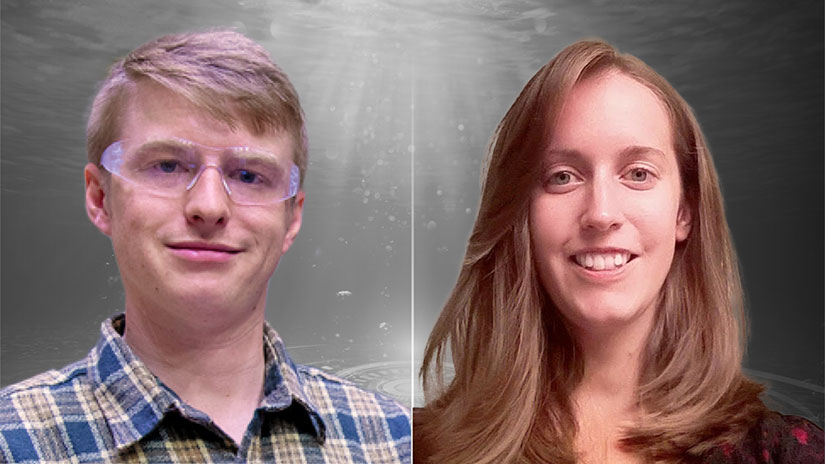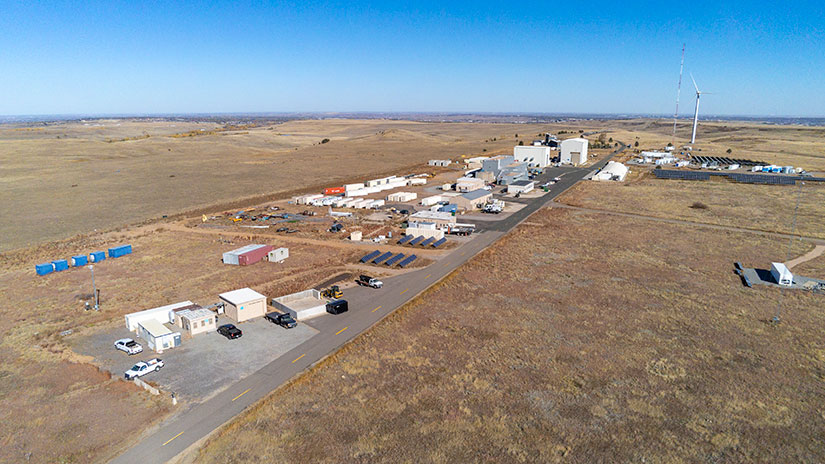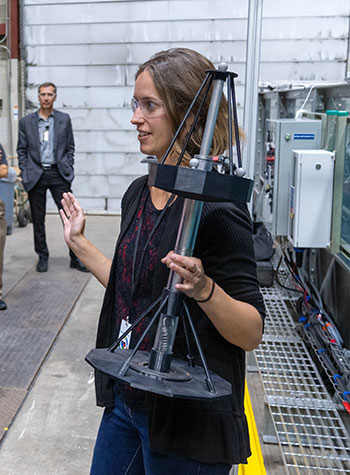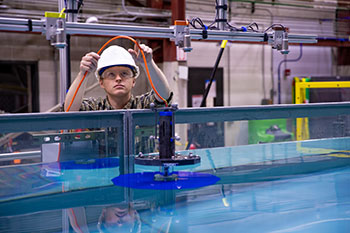Beneath the Surface: Black Boxes, Robot Arms, and a Beloved Wave Tank
Enter the Electrifying World of the Water Power Testing Team

From the outside, the Flatirons Campus looks a bit empty, even moonlike—a flat desert plateau with a few roads leading to boxy, modular, warehouse-like buildings. But inside, there is a whir of activity. This is where the future of clean energy is assembled. And it is the domain of the water power testing team.
Marine energy (also called ocean energy) technologies are a bit like moon landers or Mars rovers. Each must survive an inhospitable environment (the ocean) to serve its purpose—generating clean, reliable energy—and no two designs are exactly the same.
Just like the technologies they work to perfect, the National Renewable Energy Laboratory’s (NREL’s) water power team is far from monolithic: Modelers forecast the future of technology designs and ocean energy. Economic analysts study a technology’s financial potential. And engineers help turn promising ideas into functioning prototypes.
And the testing team? They make sure all that varied research happens as smoothly as possible. For example, the team puts new technologies through rigorous tests, tinkers with designs, and purchases new instruments, like the laboratory’s wave tank and motion platform, to perform even better tests. In short, they help guide these devices from the lab to the ocean and, eventually, the market.
To spotlight these testing treasures, we spoke to two NREL researchers who shared stories about their career origins (which involved PVC pipes and weather forecasting) and their day-to-day work. (Many of the cutting-edge testing technologies available at NREL’s Flatirons Campus—and mentioned here—were purchased with funding from the U.S. Department of Energy’s Water Power Technologies Office).
This Q&A has been edited for clarity and length.
So, first things first. What do y'all do?
Rebecca Fao, research engineer in NREL's water power technology group: I manage a portfolio of work that is done in the facilities. That includes determining new investments in testing machinery and making it easier for researchers to do their jobs. I have the bird’s eye view as opposed to Charles, who gets to focus on the details of specific projects.
Charles Candon, mechanical engineer in NREL’s water power technology group: I was just in the lab, building something.
Really? What?
Charles: Something called a black box. It’s a data acquisition system. The idea is this would be the last thing to survive on a marine energy device if it gets lost or breaks down. It’ll send out a heartbeat to give away the device’s position.
Like an airplane’s black box?
Charles: Yep, that’s where we got the name.
So, if you focus more on the details, as Rebecca said, what do you do day to day?
Charles: A lot of different things. It’s pretty fun. Sometimes I’ll be in the lab assembling stuff. Sometimes I’ll spend all day on my computer designing technologies or writing software for devices, so operators can, for example, control how much energy they produce. And sometimes I'll be in the wave tank facility running tests. It varies a lot.

OK, now that we know what you do, I’m curious to know why you chose this path. Did you always know you’d end up in this kind of career?
Rebecca: No, no. I always thought I was a history person. I love history. Still do. But I'm an incredibly practical person. What do you do with a history degree? I didn’t want to be a teacher. I thought maybe I’d go into psychology, but I took a class in high school and hated it.
It turned out I was really good at physics. My physics teacher pulled me aside and said, “If you don’t go to college for some kind of science, that’s going to be a shame.” I took a meteorology class that was kind of cool, and meteorology is basically physics just more focused on the atmosphere. So, I got a degree in meteorology.

Meteorology! Very cool. But you’re not a meteorologist. What happened?
Rebecca: I thought I was going to be a forecaster for the National Weather Service, but I quickly figured out forecasting is not my thing. I really don’t like it. I find it boring.
So, how did you go from forecasting to facilities?
Rebecca: When I was an undergraduate student, I fell in love with field deployments and instrumentation, like airborne and spaceborne remote sensors. But as an atmospheric scientist, I was studying climate change but not really contributing to any kind of solution, which I found very frustrating. When I moved to Colorado, NREL’s location and mission statement made it a natural choice.
Wow. How about you, Charles, did you always know you’d become an engineer?
Charles: Definitely. My aunt got me PVC pipes for my 5th or 6th birthday, and I thought that was the coolest thing ever. I would play with the pipes and assemble them into water treatment plants. I feel super lucky that I knew what I wanted to do and actually enjoy it. Not everyone has that.
OK, so engineering was a sure thing. But why choose renewable energy?
Charles: I grew up in Atlanta, Georgia, and my family has been super vocal about climate change and the importance of respecting the environment. In school, too, teachers would say, “Your generation has to figure out how to fix this.”
No pressure or anything. Did you expect to end up in water power?
Charles: When I got a job in NREL’s water power group, I had no idea people were doing research in water power. I always pictured myself working in wind, honestly, because as a mechanical engineer, I figured, wind turbines, that's a mechanical system. But there’s so much more to work on all throughout renewable energy.
Rebecca: I also thought I would work in offshore wind energy, honestly. That was a more natural place for me with my atmospheric science background.
So, neither of you pictured yourselves in marine energy. Are you excited to be here?
Rebecca: Yeah. I like that it hasn’t been solved yet. Wind energy is fairly mature. And wave obviously isn’t. There’s still a lot of work to be done to identify the most cost-effective and resilient designs as opposed to just trying to improve something that’s already pretty efficient.
Charles: It’s definitely a challenge to figure out what works and what doesn’t. But I think that’s one of the best things about working in water power: not having a rulebook and being able to experiment with new things.
What gets you most excited about your work? Is there a specific instrument or project that you’ve enjoyed most?
Rebecca: Getting the wave tank set up and operational.
Charles: Definitely the wave tank. I operate the wave tank for most of the projects that come in. That's kind of my domain. But we also have a really cool robot arm that can automate manufacturing. Me and another engineer are going to get a 3D printing head for it, so it can print something the size of me or a tidal turbine blade.

Woah. So, it sounds like your team harnesses all the diverse instruments at the Flatirons Campus to help move promising devices from concept to prototypes that could, eventually, go in the ocean. Is that right?
Rebecca: That's basically what our team does, yeah. We fill that gap between modeling to commercialization to help determine, OK, is this a viable solution? Otherwise, you’re going to build something based on a model, throw it in the ocean and say, “OK, fingers crossed it works.”
Charles: That’s where we can come in and do research with a little bit less risk. We can do that experimentation so the industry can take that research, apply it, and become self-sustaining.
So, Charles, now that you’re basically the Poseidon of the wave tank, do you think you’ll stay in water power?
Charles: Hopefully. Research and development is where I want to be, engineering and tinkering and building things. The fact that I get to do that for a job, come in and design things on the computer, order parts online, manufacture things, and have all these experts help me build high-quality things, whether that's a wave energy converter or a data acquisition device … I just really like building cool stuff.
It’s almost like you're doing what you did as a kid but with a much bigger budget.
Charles: Yeah, I know. It’s awesome.
Learn more about the diverse instruments available at NREL’s Flatirons Campus, and come work with us to help launch your water power technology or career. Check out more Beneath the Surface profiles. And subscribe to the NREL water power newsletter, The Current, for the latest news on NREL's water power research.
Last Updated May 28, 2025
